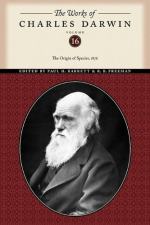
|
| Name: _________________________ | Period: ___________________ |
This test consists of 15 multiple choice questions and 5 short answer questions.
Multiple Choice Questions
1. How do biologists classify organisms?
(a) Groups of resemblance.
(b) Groups of functions.
(c) Groups of internal features.
(d) Groups of locations.
2. What insect does Darwin offer as an example of having a naturally selected trait that is NOT beneficial?
(a) Fly.
(b) Spider.
(c) Aphid.
(d) Bee.
3. Why do scientists believe fossils do not exist at the bottom of the ocean?
(a) Too much pressure.
(b) No species that far down.
(c) They cannot get to the bottom.
(d) Fossils are only found on land.
4. What does Darwin state is a main difference between first generation mongrels and first generation hybrids?
(a) First generation mongrels show no variation.
(b) First generation mongrels are larger.
(c) First generation mongrels show less variation.
(d) First generation mongrels show more variation.
5. Where might a species who are adapted to warm climates migrate to as the climate becomes colder?
(a) Mountains.
(b) North Pole.
(c) Equator.
(d) South Pole.
6. What period in time can explain many migrations due to climate change?
(a) Industrial Age.
(b) Thermal Age.
(c) Technological Age.
(d) Ice Age.
7. In Geographical Distribution continued, what does Darwin suggest about the rule of natural selection?
(a) It is different on islands.
(b) There is a common ancestor.
(c) It does not apply to all species.
(d) It applies to all species.
8. What geological process destroys fossils?
(a) Erosion.
(b) Earthquake.
(c) Lightning.
(d) Flood.
9. What does the bone structure of the human hand resemble?
(a) Wing of a bat.
(b) Paw of a dog.
(c) Hoof of a horse.
(d) Fin of a fish.
10. What do commonalities of species found on islands say about species in general?
(a) They descend from a common ancestor.
(b) They migrate.
(c) They were created independently.
(d) There are many variations.
11. What is correlated with a difference in creatures that inhabit a region?
(a) The barriers of that region.
(b) Mating potential.
(c) Migration patterns.
(d) Food supply.
12. What does the fossil record show about natural selection?
(a) Adaptations.
(b) Variations.
(c) Quick change.
(d) Gradual change.
13. What species of bee builds the most efficient hives?
(a) Honeybees.
(b) Yellowjackets.
(c) Hive-bees.
(d) Bumblebees.
14. What animal that is alive today could be considered an intermediate species of a mammal and the mastodon?
(a) Ox.
(b) Elephant.
(c) Mammoth.
(d) Tiger.
15. What species of bees builds inefficient hives?
(a) Honeybees.
(b) Hive-bees.
(c) Bumblebees.
(d) Yellow jackets.
Short Answer Questions
1. How is the American cuckoo different from the European cuckoo?
2. What type of species are most likely to inter-breed?
3. What is the general quality of fossils gathered by paleontologists?
4. How do some scientists try to explain the purpose of rudimentary organs?
5. What do many organisms of oceanic islands resemble?
|
This section contains 461 words (approx. 2 pages at 300 words per page) |

|




